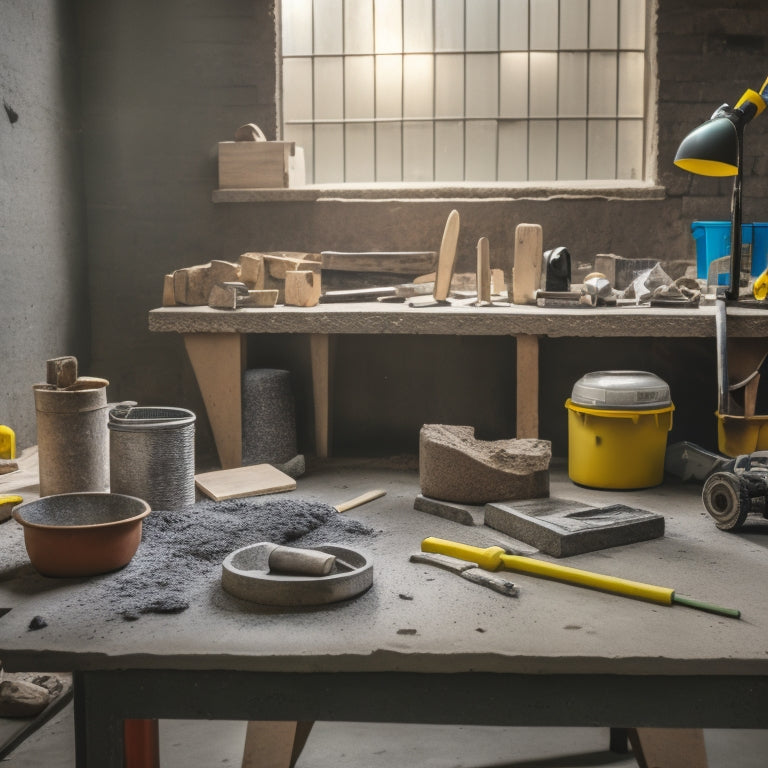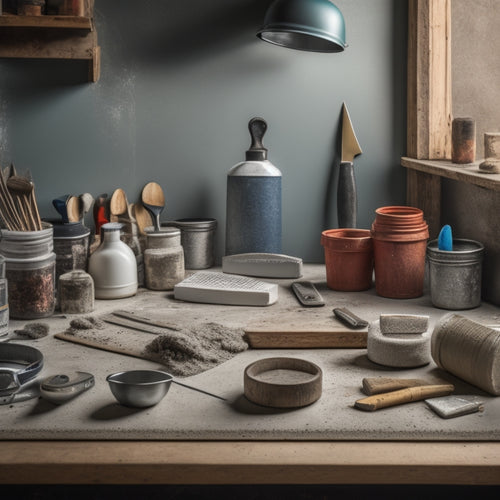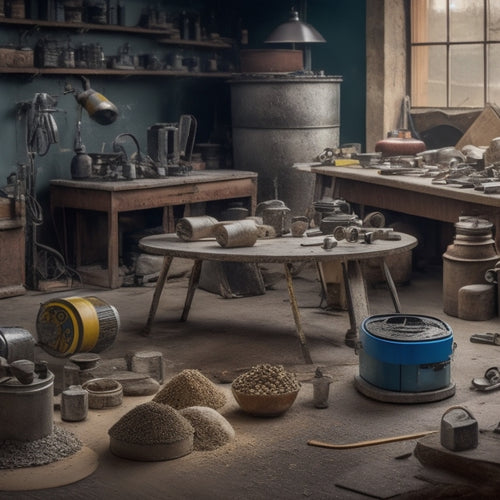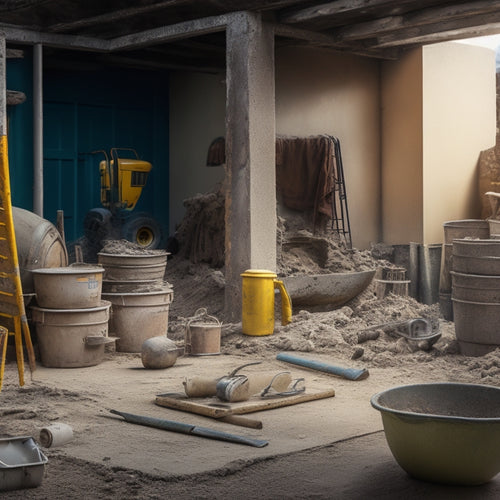
3 Best Concrete Block Construction Tools for DIY
Share
You'll need a spirit level to guarantee your blocks are perfectly aligned and level, a string line and pins to maintain a straight course during installation, and a block laying trowel to apply and smooth mortar effectively. These three essential tools will lay the foundation for a strong and visually appealing concrete block structure. By investing in these must-haves, you'll be well on your way to achieving professional-grade results. As you continue to build your toolkit, you'll discover more specialized tools and techniques to take your project to the next level.
Key Takeaways
• A spirit level is essential for ensuring blocks are perfectly aligned and level during DIY concrete block construction.
• A block laying trowel is necessary for applying and smoothing mortar effectively, achieving a strong bond between blocks.
• A jointing tool is vital for finishing and sealing joints between blocks, creating a watertight seal and preventing water damage.
• A mixing bucket or scoop is crucial for guaranteeing accurate proportions of materials when mixing mortar for DIY concrete block construction.
• Protective gear, including gloves, safety glasses, and a dust mask, is a must-have for ensuring safety during concrete block construction.
Essential Block Laying Equipment
You'll need a set of essential block laying equipment to secure a strong and durable concrete block construction. This includes a spirit level, making sure your blocks are perfectly aligned and level. A string line and pins will help you maintain a straight course, while a block laying trowel is necessary for applying and smoothing mortar. Don't forget a jointing tool for finishing and sealing joints between blocks.
Safety equipment is also vital for block laying. Wear protective gear like gloves, safety glasses, and a dust mask to prevent injury from flying debris or dust inhalation. Steel-toed boots and a hard hat will safeguard you from heavy blocks or tools falling from heights. A first-aid kit should always be on hand in case of accidents.
Investing in a high-quality block laying equipment set will save you time and effort in the long run. It'll also guarantee a professional-looking finish and a structurally sound construction. By prioritizing safety and having the right tools, you'll be well on your way to a successful concrete block construction project.
Mixing and Mortar Tools
Accurate measuring and mixing of mortar and concrete are critical to the success of your project, and the right mixing and mortar tools will help you achieve consistent results.
You'll need a reliable measuring bucket or scoop to guarantee accurate proportions of cement, sand, and water. A mixing stick or trowel is essential for combining ingredients and achieving the right consistency. Depending on the type of mortar you're working with, you may need specialized tools, such as a pointing trowel for epoxy-based mortars or a hawk for traditional cement-based mortars.
When it comes to mixing techniques, you'll want to reflect on the type of project you're working on and the mortar type you're using. For example, a high-strength mortar may require a more intense mixing technique, while a lower-strength mortar may be more forgiving.
Having the right tools on hand will help you master various mixing techniques and achieve professional-grade results. Additionally, having a mortar mixer or drill with a mixing paddle attachment can save you time and energy.
With the right mixing and mortar tools, you'll be well on your way to creating a strong, durable, and long-lasting concrete block structure.
Finishing and Smoothing Tools
With the mortar in place, finishing and smoothing tools take center stage, enabling you to refine the surface of your concrete block structure and achieve a professional-grade finish. These tools are vital for surface preparation, allowing you to create a smooth and even surface that's free from imperfections.
Here are three essential finishing and smoothing tools you'll need:
-
Trowel: A sturdy trowel is necessary for applying and smoothing out mortar, as well as creating the desired texture and pattern. Mastering trowel techniques is key to achieving a flawless finish.
-
Float: A float is used to further smooth and flatten the surface, removing any excess mortar or imperfections. This tool helps create a uniform surface, making it easier to apply subsequent layers of mortar or finishes.
-
Edger: An edger is a specialized tool used to create clean, sharp edges and corners. This is particularly important when working with concrete blocks, as it helps define the structure's shape and prevents mortar from oozing out.
Frequently Asked Questions
Can I Use Concrete Blocks for Building a Retaining Wall?
You're wondering if concrete blocks are suitable for building a retaining wall. The answer is yes, but it's essential to take into account the retaining wall design and concrete block lifespan.
A well-designed wall with proper drainage and a strong foundation can last for decades.
Concrete blocks can withstand heavy loads and harsh weather conditions, making them a durable choice.
With proper installation and maintenance, your concrete block retaining wall can last for 50 years or more.
How Do I Ensure Proper Drainage in My Concrete Block Construction?
You're about to create a retaining wall that'll withstand the forces of nature, but first, you need to avoid the catastrophic consequences of poor drainage!
Imagine a wall that's more like a dam, holding back a torrent of water. To avoid this, you'll need to design a robust drainage system, ensuring water flows freely behind the wall.
Pay attention to block placement, leaving space for water to escape. Don't risk your wall's integrity - prioritize drainage and reap the rewards of a sturdy, long-lasting structure!
Are There Any Specific Safety Precautions for DIY Concrete Block Projects?
When tackling a DIY concrete block project, you'll want to prioritize safety above all else.
First, make certain you're equipped with the right safety gear, including gloves, goggles, and a dust mask.
Next, focus on site preparation by clearing the area of debris and tripping hazards. This will help prevent accidents and guarantee a smooth workflow.
Can I Use a Hammer Drill for Drilling Into Concrete Blocks?
As you stand at the foot of the concrete fortress, hammer drill in hand, you're about to commence a battle of wills. Will your tool emerge victorious, or will the concrete block prove too formidable?
You'll need a rotary hammer drill with a carbide-tipped bit to conquer this beast.
Employ a steady, gentle pressure and a slow, consistent drilling technique to avoid damaging the block.
With the right hammer drill type and technique, you'll triumph over this concrete stronghold.
Do I Need to Seal My Concrete Blocks After Construction Is Complete?
You're wondering if you need to seal your concrete blocks after construction is complete. The answer is yes, you should.
Block sealing is essential for moisture prevention, as it helps protect your structure from water damage and erosion. Unsealed blocks can absorb water, leading to cracks and weakening the overall structure.
Conclusion
You've got the right concrete block construction tools for your DIY project.
Now, don't let the thought of mixing and laying blocks intimidate you - it's a manageable task. Yes, it requires some physical effort, but with the essential block laying equipment, mixing and mortar tools, and finishing and smoothing tools, you'll be able to achieve professional-looking results.
Remember, precision and patience are key, so take your time and focus on doing it right.
Related Posts
-

Essential Tools for Concrete Wall Covering Projects
When tackling a concrete wall covering project, you'll need a range of essential tools and equipment. For cleaning an...
-

Top DIY Concrete Grinding and Polishing Tools
When selecting DIY concrete grinding and polishing tools, you'll want to take into account a range of factors to guar...
-

What Tools Are Needed for Concrete Wall Foundations
You'll need a thorough array of tools and equipment to construct a concrete wall foundation that meets structural int...


